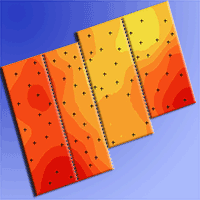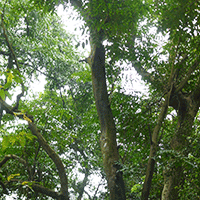
Availability and evaluation of European forest soil monitoring data in the study on the effects of air pollution on forests
iForest - Biogeosciences and Forestry, Volume 4, Issue 5, Pages 205-211 (2011)
doi: https://doi.org/10.3832/ifor0588-004
Published: Nov 03, 2011 - Copyright © 2011 SISEF
Research Articles
Collection/Special Issue: COST Action FP0903 (2010) - Rome (Italy)
Research, monitoring and modelling in the study of climate change and air pollution impacts on forest ecosystems
Guest Editors: E Paoletti, J-P Tuovinen, N Clarke, G Matteucci, R Matyssek, G Wieser, R Fischer, P Cudlin, N Potocic
Abstract
In the study of air pollution effects on forest ecosystems, solid soil data such as cation exchange capacity, base saturation and other exchangeable cation fractions, soil texture, soil moisture, soil weathering rates, C/N ratio and other variables form an important information base for many air pollution impact models. This paper shows some of the possibilities and the limitations of the soil data that European countries collected on the systematic Level I and on the intensive and permanent Level II monitoring plots within the ICP Forests programme. The soil data date from a first inventory in the 1990s and from a second inventory more than 10 years later. Both surveys were conducted following a common manual on sampling and analysis of soil. An example of the changes in pH(CaCl2) and base saturation in the forest floor and mineral soil on more than 2000 plots till a depth of 80 cm between the two surveys is presented. In this period the pH(CaCl2) significantly increased in the very acid forest soils [with pH(CaCl2) below 4.0] but further decreased in forest soils with pH(CaCl2) above 4.0. Following the trend in pH, the base saturation increased in soils with a very low buffering capacity (soils with a base saturation below 20% in the first inventory) and decreased in forest soils with reference base saturation values above 20%. There is both a decrease of soil pH and base saturation in the forest floor of the Arenosols and Podzols. In the Podzols this decreasing trend could not be established in the mineral soil, though this decreasing trend persisted in a number of mineral soil layers of the Arenosols. The only consistent increasing trend of pH and base saturation when stratifying according to the WRB reference soil groups was seen in the forest floor of the Luvisols and Cambisols.
Keywords
Forest soils, Soil acidification, Soil monitoring, ICP Forests
Authors’ Info
Authors’ address
Corresponding author
Paper Info
Citation
Cools N, De Vos B (2011). Availability and evaluation of European forest soil monitoring data in the study on the effects of air pollution on forests. iForest 4: 205-211. - doi: 10.3832/ifor0588-004
Paper history
Received: Nov 30, 2010
Accepted: May 15, 2011
First online: Nov 03, 2011
Publication Date: Nov 03, 2011
Publication Time: 5.73 months
Copyright Information
© SISEF - The Italian Society of Silviculture and Forest Ecology 2011
Open Access
This article is distributed under the terms of the Creative Commons Attribution-Non Commercial 4.0 International (https://creativecommons.org/licenses/by-nc/4.0/), which permits unrestricted use, distribution, and reproduction in any medium, provided you give appropriate credit to the original author(s) and the source, provide a link to the Creative Commons license, and indicate if changes were made.
Web Metrics
Breakdown by View Type
Article Usage
Total Article Views: 56657
(from publication date up to now)
Breakdown by View Type
HTML Page Views: 46813
Abstract Page Views: 3736
PDF Downloads: 4456
Citation/Reference Downloads: 33
XML Downloads: 1619
Web Metrics
Days since publication: 5159
Overall contacts: 56657
Avg. contacts per week: 76.88
Citation Metrics
Article Citations
Article citations are based on data periodically collected from the Clarivate Web of Science web site
(last update: Mar 2025)
Total number of cites (since 2011): 28
Average cites per year: 1.87
Publication Metrics
by Dimensions ©
Articles citing this article
List of the papers citing this article based on CrossRef Cited-by.
References
Commission Regulation (EEC) No 926/93 of 1 April 1993. OJL 100, 26.4.1993, pp. 1-47.
Gscholar
Regulation (EC) No 2152/2003 of the European Parliament and of the of 17 November 2003 concerning monitoring of forests and environmental interactions in the Community (Forest Focus). OJL 324, 11.12.2003, pp. 1-8.
Gscholar
Quality assurance and quality control in forest soil analysis: 3rd FSCC interlaboratory comparison. Forest soil co-ordinating centre, Rapporten van het Instituut voor Bosbouw en Wildbeheer - sectie bosbouw 2003 (018). Institute for Forestry and Game Management, Geraardsbergen, Belgium, pp. 83.
Gscholar
Quality assurance and quality control in forest soil analysis: 4th FSCC interlaboratory comparison. INBO.R.2006.6. Forest Soil Coordinating Centre, Research Institute for Nature and Forest, Geraardsbergen, Belgium, pp. 66.
Gscholar
Quality assurance and quality control in forest soil analysis: 5th FSCC interlaboratory comparison. INBO.R.2007.46. Forest soil coordinating centre, Research Institute for Nature and Forest, Geraardsbergen, Belgium, pp. 63.
Gscholar
6th FSCC interlaboratory comparison 2009. Rapporten van het Instituut voor Natuur- en Bosonderzoek 2010. INBO.R.2010.4. Research Institute for Nature and Forests, Brussels, Belgium, pp. 52.
Gscholar
Acidic deposition: sources and effects. Encyclopedia of Hydrological Sciences, John Wiley & Sons, NY, USA.
Gscholar
Acidification of forest soils in Sweden. Ambio 21: 150-154.
Gscholar
Soil atlas of Europe. European Soil Bureau Network, Office for Official Publications of the European Communities, EUR 21676 EN, Luxembourg, pp. 128.
Gscholar
World reference base for soil resources 2006. FAO, Rome, Italy, pp. 128.
Gscholar
World reference base for soil resources 2006 (first update 2007). FAO, Rome, Italy, pp. 116.
Gscholar
Soil quality - determination of particle size distribution in mineral soil material - method by sieving and sedimentation. International Organization for Standardization, Geneva, Switzerland, pp. 30.
Gscholar
Soil geographical database for Eurasia & the Mediterranean: instructions guide for elaboration at scale 1:1.000.000. Version 4.0. EUR 20422 EN. Office for Official Publications of the European Communities, Luxembourg, pp. 64.
Gscholar
United nations economic commission for Europe: convention on long-range transboundary air pollution. International co- operative programme on assessment and monitoring of air pollution effects on forests. Manual on methodologies and criteria for harmonized sampling, assessment, monitoring and analysis of the effects of air pollution on forests.
Gscholar
Forest soil condition in Europe. Results of a large-scale soil survey. Forest soil co-ordinating centre, Brussels, Belgium, pp. 261.
Gscholar
Chemical fluxes in time through forest ecosystems in and the UK - soil response to pollution recovery. Environmental Pollution 158 (5): 1857-1869.
CrossRef | Gscholar

















